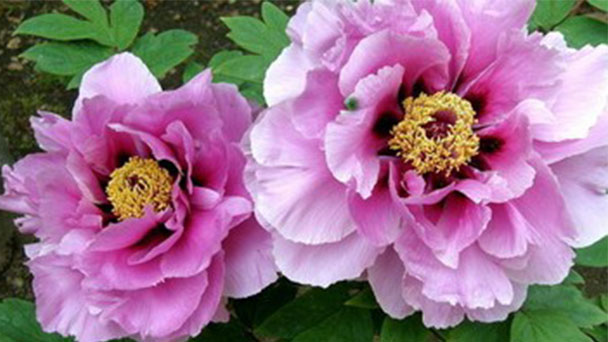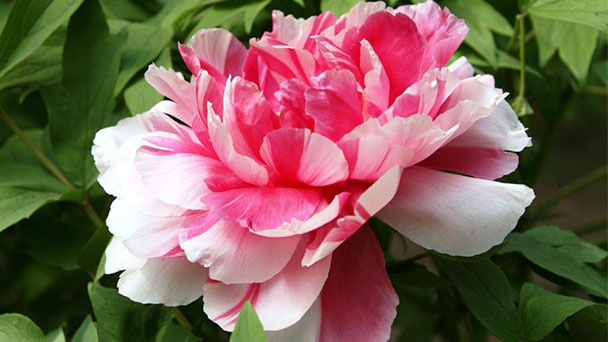Peony Profile
Written by Joy
Dec 15 2020



Peony morphological characteristics
Peony is a deciduous shrub. Stems up to 2 m high; The branches are short and thick. The leaves are usually two or three compound leaves, and normally the leaves near the tip of the branch are 3 leaflets. Terminal leaflets are broadly ovate, 7 to 8 cm long, 5.5-7 cm wide, 3-lobed to middle, lobes unlobed or 2-3 lobed, with the surface green, glabrous, abaxially pale green, sometimes white, sparsely pubescent or sub glabrous along veins, petioles 1.2-3 cm long; Lateral lobules are narrowly ovate or oblong-ovate, 4.5-6.5 cm long, 2.5-4 cm wide, subsessile.Peony growth habit and growing environment and distribution
Peony adapts to a warm, cool, dry and sunny environment. It likes the sun, which is also resistant to half shade, cold, drought, weak alkali resistance, and avoid water, afraid of heat and direct sunlight. It is suitable to grow in loose, deep, fertile, high-dry and well-drained neutral sandy loam. Poor growth in acidic or heavy soils. The largest and most concentrated area of peony cultivation is Heze, Luoyang, Beijing, Linxia, Pengzhou, Tongling County and so on. In winter, flower farmers from the main Plains hurried to Guangdong, Fujian, Zhejiang, Shenzhen and Hainan to urge peony to flower, which promoted peony to settle in the above regions and spread peony planting all over Provinces and autonomous regions in China.Peony efficacy and role
The flower of Peony is slightly cold, bitter taste, and spicy. Clearing heat and cooling blood, activating blood circulation and removing stasis. Modern researches have shown that peony bark has antibacterial, anti-inflammatory, anti-allergic, anti-tumor, hemostasis, antipyretic, sedative, analgesic, spasmolysis and other benefits, but also can improve the specific immune function of the body, and increase the weight of immune organs. Besides ornamental, it can also be widely used as medicine for regulating menstruation and promoting blood circulation.Peony cultivation
The way of cutting propagation is to cut the cuttings first and then insert them into soil or other substratum to make them take root and become new plants. The branch that peony cutting propagates, needs to choose those sent out by peony root soil bud branch that year, or when peony is plastic clip, choose the stem to enrich, terminal bud is full and the branch that does not have pest and disease makes spike, 10-18 centimeters in length. The root of peony is fleshy, like high dryness, bogey dampness, drought resistance. Therefore, the seedling bed should be ventilated in the sun place in order to build a high bed seedling. While cutting, insert a check watering a check, a through watering.Peony pests and controls
Grubs: Larva of a scarab. All the year round there are hazards, to May - September serious. It will harm peony root, bite into uneven holes or incomplete broken, resulting in part on the ground grow weak or die, seriously affect the yield and quality. Prevention and control methods: in the morning will be killed seedlings, plants, pick and kill;Lights entrap and kill adults; Pour root with 50% octyl thiophosphorus oil or 90% trichlorfon 1000-1500 times liquid;3% carbofuran granule 2 kg per mu, mixed with moist fine soil 20-50 kg;Combined with intertilled weeding along the ridge.
Small ground tiger: also known as "ground silkworm", is a multi-feeding underground pest.Generally in the spring and autumn, the most serious harm, often from the ground to bite off seedlings or ununearthed buds resulting in the lack of seedlings broken peony.Prevention and control methods: early morning before sunrise, in the vicinity of the killed seedlings artificial kill;In the early larval stage, 98% trichlorfon crystal 1000 times liquid or 50% octyl thiophosphate 1000 times liquid was sprayed;In the advanced stage of larva, it can be killed by poison bait. 98% trichlorfon crystal or 50% xiphoxiphop emulsion of 100-150 grams is dissolved in 3-5 kilograms of water per mu, and sprayed on 15-20 kilograms of chopped fresh grass or other green fertilizer, mixed evenly while spraying, and dispersed in the evening along the line around the seedlings, which can get a good control effect.
Brillaria: more in the spring, the adult peony in the root spawning, after hatching, the larvae drill into the root, gradually upward food decay, light of the stem and leaves yellow, heavy of the whole plant died.Control methods: Find damaged peony plants, break roots and stems, kill pests;Spray more than 80% trichlorfon 800-1000 times liquid, or 2.5% trichlorfon powder per mu.
Termites: termites are often induced by applying cake fertilizer. They eat the peony root skin, damage the shoots, and make the leaves turn yellow.Control method: apply cake fertilizer before termites come out of the hole, do not touch the root.Drench the roots with new tea cake water or 50% c3P 200-500 times.
Peony flower language
First, the flower is famous as the king of flowers. It is full, affectionate, rich and noble.Second, it stands for life, expect, light love.
Third, it represents noble, elegant, graceful, beautiful, beautiful, trustworthy people.
Latest Updated
- Benefits of Bugleweed - 7 Science-backed Health Benefits
- Bugleweed Dangers & Side Effects - Is It Poisonous?
- How to Plant Evergreen Trees - What You Should Know
- When to Plant Evergreens - Grow Guide for Evergreen Trees
- 12 Wonderful Evergreen Shrubs for Your Garden
- 12 Popular Evergreen Plants with Pictures for Beginners
- When And How To Prune A Lilac Bush Like a Pro
- How to Grow & Care for Lilac Vine (Hardenbergia Violacea)
- Japanese Lilac Tree (Syringa Reticulata) Care & Propagation Guide
- Shumard Oak Pros and Cons - What to Know
Popular Articles
- Winter maintenance of Antirrhinum Majus
- How to Grow Terminalia Mantaly Tree
- How to Grow and Care for Crossostephium Chinense
- How to grow Antirrhinum Majus in spring
- Peristeria Elata (Dove Orchid) Profile: Info & Care Guide
- Underwatered Snake Plant (Sansevieria Trifasciata) - Signs And How To Fix
- How to Care for Brazilian Jasmine Plant (Mandevilla Sanderi)
- How to Grow & Care for Graptopetalum Purple Delight in Summer
- Rosa Chinensis (China Rose): Plant Growing & Care Tips
- How to Care for Baby Sun Rose (Aptenia Cordifolia)